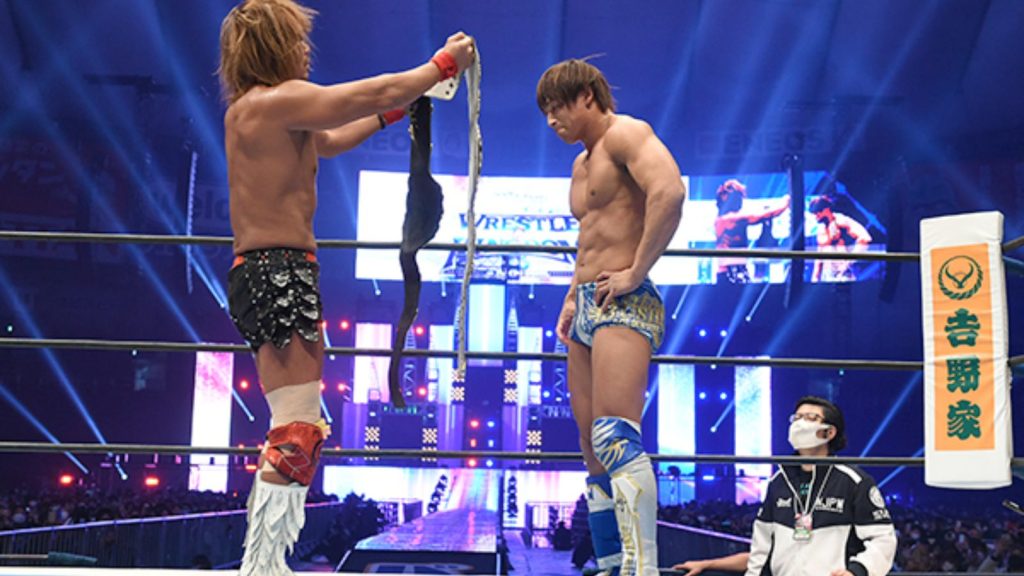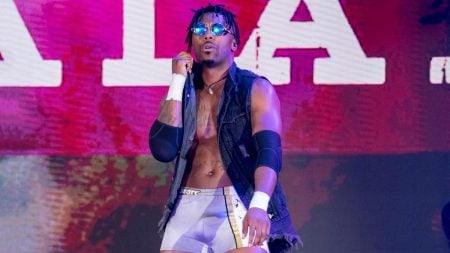New Japan Pro Wrestling has lost its top stars. The glory days of yesteryear are over. The company is in crisis. It is 1988. It is 2024. It is 2006. And a new generation is born.
- Wrestle Kingdom 1-5 (2007-2011) – NJPW rebrands its annual January 4th show at the Tokyo Dome after a video game from the company that purchased them, Yuke’s.
- Wrestle Kingdom 6-10 (2012-2016) – NJPW is bought by Bushiroad and enters the Internet Age under Hiroshi Tanahashi, Shinsuke Nakamura, and Kazuchika Okada.
- Wrestle Kingdom 11-15 (2017-2021) – NJPW enters the Global Age and expands its focus to the Western audience, featuring Tetsuya Naito, Kenny Omega, and Kota Ibushi.
Naito, Ibushi, and the Global Age Pt 2 – Wrestle Kingdom
New Japan in this era is often praised for long term booking, but these five year periods were not planned. No one can predict the good nor the bad. Life just has a way of working these things out.
There are two truths that become evident when looking back and learning from pro wrestling history. 1) Always have a backup plan. 2) Time is a squared circle.
NJPW in 2019
While Kenny, Hangman, Cody, and the Young Bucks left for AEW early in 2019, New Japan’s ambitions continued to grow. Grander venues, more international shows, and two nights of Wrestle Kingdom at the Tokyo Dome were among their lofty goals.
Jay White had won the IWGP title in February, furthering his Rainmaker shock redux. Though it wasn’t as desperate a move considering his rise in 2018, the word was that he was being slotted into the role that Omega left.
And with Okada winning the New Japan Cup, the stage was set for the G1 Supercard in a sold-out Madison Square Garden over Wrestlemania weekend.
The joint show juxtaposed one company that was at its hottest and one that was just the opposite. The NJPW matches were praised, most notably for a historic title change when Okada beat Jay White.
Meanwhile, everything Ring of Honor did was panned: most notably a worked-shoot invasion angle with WWE castoffs. Even as AEW took the wrestling world by storm with Double or Nothing in May, NJPW stayed loyal to their American partner, ROH.
Los Ingobernables de Japon saw a major push in the first half of the year. Sanada went toe to toe with Okada twice in losing efforts.
Shingo ran through his block in the Best of the Super Juniors before losing in an amazing Finals match with Will Ospreay. Also, Naito and Ibushi had their infamous series of matches over the IC title that featured some of the scariest neck bumps of all time.
The search for Okada’s next great rival raged on. Jon Moxley came over for the first time to compete in the G1 Climax. He and Jericho represented the Forbidden Door between AEW and NJPW, being the only wrestlers working for both companies amidst their cold war.
Also looking for a shot at the title in the G1 were Ospreay entering for the first time, Takagi floating between weight classes, and Kenta coming off his WWE run. Sanada would score a rare win over Okada in the A Block but would lose the rematch for the belt down the road.
The finalists were Jay White and Kota Ibushi, with Ibushi overcoming his failure from last year’s Finals against Tanahashi and indeed winning a main event spot at the Tokyo Dome.
Omega said at the time that Ibushi would’ve gone to AEW if he had asked him, but Kenny knew it was his dream to become the IWGP Heavyweight champion.
Wrestling in the fall of 2019 was at a fever pitch. WWE and AEW were battling on national TV in the Wednesday Night Wars. ROH, for as weak as they had become, were trying to sign big names and were soon to name Bullet Club’s Marty Scurll as the booker.
And NJPW was building to the monumental two nights of Wrestle Kingdom, where January 5th would see one man hold the top two belts as IWGP Heavyweight and Intercontinental champion.
Wrestle Kingdom 14, Night 1
January 4, 2020: The traditions of the Tokyo Dome show were challenged. In October, NJPW’s parent company Bushiroad had purchased World Wonder Ring Stardom, the leading promotion in joshi wrestling.
The non-broadcasted dark match saw Mayu Iwatani and Arisa Hoshiki defeat Hana Kimura and Giulia. Blending a men’s and women’s company was a bold move, but Stardom got some exposure, and New Japan caught a glimpse of the future.
The official pre show matches, meanwhile, saw a look back at the past. A plethora of multi-man tags were back.
First was a showcase of the young prospects: homegrown guys like Yota Tsuji and Yuya Uemura against LA Dojo guys like Clarks Connors and Alex Coughlin. Along with the likes of Ren Narita and Shota Umino, this was the upcoming 7th generation.
At the same time, the 3rd generation was still saying their goodbyes, as Yuji Nagata and Manabu Nakanishi lost to Tencozy, Hiroyoshi Tenzan and Satoshi Kojima.
The main card opened with Jushin Thunder Liger concluding his retirement tour of the last year in an 8-man tag featuring many of the old time legends. Liger was the one to take the fall on Night 1.
Next, Suzuki-gun beat LIJ in an 8-man to build some intrigue between ZSJ and Sanada. After that, Chaos beat Bullet Club in an 8-man to build towards Goto vs Kenta.
Another tradition that survived was upcoming stars winning the tag titles when FinJuice defeated Guerrillas of Destiny.
Juice Robinson had distinguished himself in the G1 before winning the Tag League with David Finlay, who missed most of last year on injury.
Wrestle Kingdom’s top-4-match quality was also kept intact, kicking off with Moxley vs Lance Archer in a Texas Deathmatch. Moxley had beaten Juice for the US championship on first night, but was stripped of the title due to a weather delay of his flight to Japan.
Archer had become a bit of a singles star and he went to war with the AEW wrestler. They hit each other with all sorts of plunder before Moxley barely beat the count to win back his belt.
The bar was raised even higher with Hiromu Takahashi making his big-stage return after a year and a half recovering from a broken neck, challenging Ospreay for the Junior Heavyweight title.
And Hiromu didn’t miss a beat. Both men looked to be two of the craziest, most death-defying wrestlers to ever step into the ring. The match was phenomenal, with Hiromu winning the title and proving why he is the god of that division.
Another persisting pillar of Wrestle Kingdom was the idea of the double main event, not just within Night 1 but the question if January 4th or 5th would capture the essence of the true Tokyo Dome main event.
The first leg of the Double Gold Dash saw Naito challenging Switchblade for the IC title. 2019 had been a breakout year for Jay White, seeing him grow into the role as the perfect villain and grow out his beard over the summer.
The crowd went wild for the heel tactics and babyface in peril, concluding in a raucous ovation when Naito won and got back his old lover, the white IC belt.
January 4th concluded with G1 winner Kota Ibushi challenging Okada for the IWGP title. Ibushi has had a long road to the Tokyo Dome main event, filled with injuries and near misses.
But for all the times he landed on his head in this bout, he brought the same energy in trying to destroy Okada. His physique had gotten bigger. His attitude had gotten meaner. But after a long and exciting battle, the Ace retained at the end of the night.
Wrestle Kingdom 14, Night 2
January 5, 2020: Concerning the experiment of the two nights of Wrestle Kingdom, Night 1 was a sellout at over 40,000 paid, and Night 2 did 30,000 paid. What was once their ceiling was now a bonus.
After 5 hours of wrestling the previous day, the crowd returned to see one pre-show match with the LIJ team of Evil, Takagi, and Bushi winning the 6-man titles.
The main card opened with Liger’s retirement match as he teamed with rival Naoki Sano against Hiromu Takahashi and his rival (the man who broke his neck) Ryu Lee.
Hiromu pinned Liger, as if he already hadn’t taken the torch as the best Junior Heavyweight of a generation. Liger would have his retirement ceremony the next day.
Afterwards, Sho and Yoh won the Junior tag titles from Bullet Club’s Taiji Ishimori and El Phantasmo for a fourth time.
There are only so many championships and Junior Tag Leagues to win before dominance becomes stagnant. The same could be said for Hiromu, had he not just missed 500 days of his career.
The middle of the card saw a variety of singles matches, differing in style. After the high-profile year he had, Sanada was making his singles debut at Wrestle Kingdom, challenging ZSJ for the British title.
It was technical wrestling at its finest, smooth counter after smooth counter until ZSJ reversed a pin for a quick win. The blonde wrestler’s story of adversity continued, years from being finished.
Next, Juice challenged Moxley for the US title in a wild brawl involving chairs. Mox retained the belt and took it back to AEW.
Afterwards Goto challenged Kenta for the NEVER title, and also to avenge Katsuyori Shibata after Kenta beat him down in a brutal betrayal in which most thought Shibata was lucky to be alive let alone getting into a physical angle.
It was a hard hitting bout with Goto getting the win and delivering a classic top 4 match.
After they lost the night before, Switchblade and Ibushi fought for third place in the Double Gold Dash. White did great at cowardly heel work.
Ibushi did great at his no-selling fury. But perhaps what brought this down from the amazing G1 Final they had was the presence of White’s manager Gedo, literally being inside the ring at times.
Bullet Club interference and referee incompetence had been a problem for years, but something about this night seemed to break the camel’s back.
Gedo hitting Ibushi with brass knuckles, leading directly to Jay White finishing him, crossed a line, for some opinions, in a top-four Tokyo Dome match.
The term Forbidden Door was coined by Tanahashi for this semi-main, claiming that if he could beat Chris Jericho, he would challenge for his AEW title.
The two companies were not in league, but a deal was made. Both men were limited for their age and tenure, but they wouldn’t have their longevity without being the best at what they do.
Jericho knows how to stay over. And after his last hurrah 366 days ago, Tanahashi has been recalibrating himself to work slower and smarter, though he is, of course, going to dive to the floor at Wrestle Kingdom.
After a heated battle, Jericho made Tanahashi tap out, signaling the end of an era for the best babyface in a century.
And in the main event, both the IWGP Heavyweight and Intercontinental championships were up for grabs in a first time stipulation between old rivals.
Naito walked to the ring dressed all in white, carrying the white strap that he once threw around in disgust but had learned to love over the past year.
For it was the IC belt that had delivered him back to the Tokyo Dome main event to conclude his Wrestle Kingdom trilogy with Okada.
The two biggest stars of New Japan were as crisp as could be and just as brutal. There were plenty of callbacks in this incredible match, but the newest wrinkle in the story was that, for once, the Dark Ace didn’t lose at Wrestle Kingdom. Naito actually won.
After being rejected by the fans in 2013 and losing in 2018, Tetsuya Naito fulfilled his destiny by winning the two top belts of New Japan Pro Wrestling in the main event at the Tokyo Dome.
And just as he was about to send the crowd home happy with the LIJ roll call, Kenta ran in and laid him out. In some ways, not being that rah-rah guy with the fans and having his parade rained on is the essence of Naito.
With one story ending and Kenta embarrassing Naito on the biggest stage, there was always another story to tell.
NJPW in 2020

The COVID-19 pandemic changed the world, let alone the landscape of pro wrestling and NJPW. From the end of February to the middle of June, NJPW did not hold a single event in Japan.
The country was on strict lockdown. Over the next few months and even years, foreign talent found it beyond difficult to enter the borders, having to quarantine for two weeks if they could get in at all.
When crowds returned, they had to be socially distanced in fewer numbers and were discouraged from making any verbal sounds behind their masks. Japan treated COVID much harsher and for much longer than the West did.
And if AEW wasn’t already going to siphon popularity as the WWE alternative, the clap-only crowd devastated the internet’s interest.
As they returned to performing at the start of the summer, the shock to wake them out of their slumber saw Evil win the New Japan Cup over Okada, turn on LIJ to join Bullet Club, and beat Naito for the double belts.
It wasn’t completely out of left field, considering the Wrestling Observer Newsletter’s reporting that Evil was always planned for something big this year and that he was usually competitive in the G1 with some signature wins.
Who wouldn’t want an upper midcarder to be elevated? What was a surprise, however, was the unsettling shift into unbearable amounts of interference, including the addition of Dick Togo as his mentor.
Going on multiple years now, Evil’s style has been derided as the worst thing about New Japan, and he was their top champion at the darkest moment.
The belts went back to Naito the following month, but desperate times called for desperate measures. Eccentric characters like Master Wato and the Great O’Khan were brought back from excursion to mixed reception.
A new title called the King of Pro-Wrestling was introduced by Okada as quite literally being “controversial”, allowing fans to vote on odd match stipulations. Not that any one idea was supposed to or even could turn business around on its own.
NJPW was losing money with smaller live gates and merchandise revenue but hadn’t fired any of its office workers. Perhaps without the lucrative two nights at the Tokyo Dome, they’d be in even worse shape.
But the sword fell upon Harold Meij to step down as President. Because of a once-in-a-century pandemic, the company failed to reach the profit that was promised. But then again, maybe he could have handled the AEW exodus better.
One story that remained constant was that of Kota Ibushi. After his double loss at Wrestle Kingdom 14, he formed a team with Tanahashi and won the tag titles.
And after finally defeating Taichi, who eliminated him from the New Japan Cup and helped take their tag titles, Ibushi advanced to the G1 finals for a 3rd time, beating Sanada to win for his 2nd year in a row.
It was a feat that hadn’t been done in 15 years. Ibushi had expressed his intent to become God. However, because he lost to Jay White during the G1, he had to defend his title shot against him, where he lost the briefcase.
With his main event spot taken away, Ibushi would have to turn to an old rival in Naito for help in gifting him the second night at the Tokyo Dome.
Wrestle Kingdom 15, Night 1
January 4, 2021: Because of Covid-19 restrictions, New Japan drew its lowest attendance in the 30-year history of Wrestle Kingdom. With plenty of factors to inflate or deflate the numbers, Night 1 essentially did 12k, and Night 2 did 7k.
The first show opened with the preshow Rambo, featuring the likes of Suzuki, Goto, and Ishii, who just three months prior were having killer matches in the G1.
The final four—Chase Owens, Bad Luck Fale, Bushi, and Yano—advanced to compete on the next day for Yano’s KOPW trophy, a much-mocked scene.
The main card opened with Hiromu vs El Phantasmo for a shot at the Junior title. Hiromu had won BOSJ for a 2nd time, and ELP won the Super J-Cup, part of the NJPW Strong initiative to tape content in America.
They pulled out crazy highspots to warm up the clap-only crowd. It’s a distinct choice to open with a singles match like this for various reasons, but the strange charisma of both men seemed to pierce through the silence. Hiromu won with a counter roll-up, setting up a rematch with the man who took his title.
The following match saw Guerillas of Destiny win the tag titles from Dangerous Tekkers (ZSJ and Taichi) to set the record for most reigns by a single team. They started slow, with both heelish teams trying to strangle each other, but it picked up in the end.
The next bout saw Kenta beat Satoshi Kojima, who was a short notice replacement for an injured Juice Robinson. Kenta won a New Japan Cup in America to win a title shot at Moxley, who was sitting on the belt for months.
Even though Kojima hadn’t been in a prominent position for years, he had enough presence to put on a fine performance against the dastardly heel.
With only six matches on the main show, it’s hard to discern what is considered the upper card.
Third from the top saw Tanahashi face The Great O’Khan in a special singles match. O’Khan is as enigmatic as his bizarre entrance, dressed as some ancient warlord with a question mark draped over his face.
He looked to grapple on the mat while also going for Mongolian chops and Iron Claws. His odd nature would almost become a distinct talking point for the next era, as his push brought up questioning his talent as compared to his abundant personality.
For now, Tanahashi worked a good match with him, pinning him after two High Fly Flows.
On the last night of A Block during the G1, Ospreay finally beat Okada after many attempts. He had to turn on his Chaos stablemate, aligning himself with Bea Priestley and the Great O’Khan to form the Empire.
Ospreay was firmly a heavyweight, shedding the moniker and style of the Aerial Assassin to step into the realm of big match Okada.
Even playing the heel, he still had to fight from below to prove himself. Okada was in an era where he was simply workshopping a new submission, the Money Clip, to mixed acclaim.
Ospreay lost in an epic bout, learning the hard lesson that the Ace doesn’t lose at Wrestle Kingdom.
In the main event, Ibushi challenged Naito for the two titles. A dangerous rivalry reignited as they hit one crazy spot after another. And a 10-year story was coming to a head.
Since the days when a thin young man couldn’t beat Prince Devitt for the Junior Heavyweight title, Ibushi had undergone a physical transformation on the path to becoming God. All the work he put in created some big muscles, broad shoulders, and a thick neck.
But even when he hit the jumping knee and Kamigoye to pin Naito, he couldn’t quite believe it. Ibushi thought the match was still going as he was being handed the belts.
Naito had to take them from the referee and crown Ibushi himself. With the IWGP and Intercontinental Championships over each shoulder, a king of two crowns was born at Wrestle Kingdom.
Wrestle Kingdom 15, Night 2
January 5, 2021: The second night at the Tokyo Dome almost felt like an epilogue. Like last year, Stardom opened the pre-show with dark matches unseen by anyone who wasn’t in the building.
Utami Hayashishita, AZM, and Saya Kamitani defeated Maika, Himeka, and Natsupoi. Syuri and Giulia defeated Mayu Iwatani and Tam Nakano.
Even after the tragic death of Hana Kimura in May, Stardom experienced a surge in popularity and streaming subscriptions during the pandemic, having been bought by Bushiroad at the end of 2019.
The main card opened with the four-way for the KOPW trophy as Yano beat Chase Owens, Bushi, and Fale in a comedy match.
In the next match, Suzuki-gun’s El Desperado and Yoshinobu Kanemaru retained the Junior Tag titles against Ryusuke Taguchi and Master Wato.
The heels looked like a well-oiled machine, while the 23-year-old Wato looked like he didn’t know where he was supposed to be. So, with about 20 minutes of in-ring time over, the Night 2 broadcast was a third of the way over.
The third match was a top 4 Wrestle Kingdom match in any year, with Shingo Takagi retaining the NEVER championship against Jeff Cobb.
The two agile hosses had a hard-hitting brawl over the default number 2 title, an excellent sign of the huge year each man was about to have.
Next was a match where Sanada defeated Evil despite the interference, weapons, and ref bumps, and it somehow wasn’t the end of the torturous experiment that was Evil and Dick Togo.
And in the semi-main, Hiromu beat Ishimori for the Junior title in an awesome match. It’s the third and not the last time he’s won the belt at the Dome.
And in the main event of Night 2, Ibushi defended the double championships against Jay White in a 48 minute epic, the longest match ever at the Tokyo Dome.
The main events of the first five Wrestle Kingdoms averaged about 20 minutes. The next five averaged closer to 30. And the last 5 pushed the boundary to 40.
Despite the heel tactics of Gedo and the Switchblade, Ibushi eventually beat him into a drooling mess. White was so out of it he thought he won after the bell rang.
With both the black and white straps shining against his chiseled physique, Ibushi took the mic in the post-match and emotionally declared to the crowd that he had “become God.”
Aftermath
New Japan from about 2012 to about 2019 was a magical run, an exciting new world where everything was different and history was written before your very eyes.
With another 5-year period of Wrestle Kingdom in the books, there are certain lessons to be learned when studying the rights and wrongs of history. There are things in life you can’t control and things in life you can.
- You couldn’t control the COVID pandemic and the government’s response
- You can control how/who you book to make a splash when the chips are down
- You couldn’t control those who decide to leave the company for another
- You can control who are the stars you invest in and when to break in case of emergency
As of this writing, the next 5 year period is still ongoing and it hasn’t looked pretty. Since 2021: the IWGP title scene has been handled poorly on multiple fronts, Kota Ibushi left in a public war with the front office, and the next generation has been stalled in development.
New Japan Pro Wrestling has been defined by strong style and fighting spirit. In the 80s, stars leaving made way for the Three Musketeers. At the turn of the 21st century, the dark age was followed by the modern Golden Age.
Now that history repeats itself in the 2020s, the betting odds say that NJPW will do their best to rise again. By Wrestle Kingdom 20, the story has the potential to be great, like a forest after the fire.
One can only do so much in trying to replace Omega, Ibushi, Ospreay, and Okada. It’s another path to look to the future and choose rebirth.







